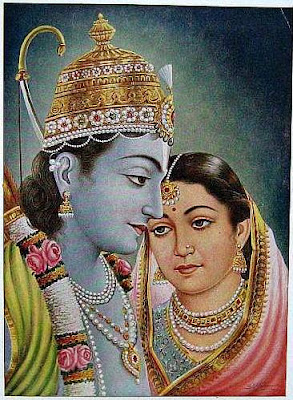Wikipedia Trail: Sita to Kali Yuga
Sita and Rama in a 1950's bazaar art piece. Source: Wikipedia
I started with Sita, who was the consort of Lord Rama, an incarnation of Vishnu. She herself, was an avatar of Lakshmi. She was one of the central figures of the Ramayana and was the Daughter of Bhumi, the earth goddess. She was adopted by King Janaka and Queen Sunaina.
This led me to Ayodhya which is an ancient city thought to be the birthplace of Rama. It is 1 of 7 different pilgrimage sites for the followers of Hinduism. There is much controversy about the present Ayodhya and the ancient Ayodhya being the same place.
Ayodhya leads me to Treta Yuga which is the second out of 4 different yugas. Yugas are the ages of mankind in Hinduism. In a way, it is like different ages (Paleolithic, Mesolithic, etc.) of the earth. During this yuga, people grew more materialistic and the power of humans diminished a slight bit. However, this period brought knowledge of the universal magnetism and humans learned and understood the nature of the universe.
Finally, I was led to Kali Yuga, which was the fourth and final yuga. Krishna's departure from the earth marked the beginning of Kali Yuga. It is referred to as the dark age because people are the furthest away from God and have a limited spiritual connection.



Comments
Post a Comment